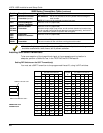
Section 5 - Wireless Expansion
5-3
Installing the 5800TM Module
Installation
of this module is necessary only if you are using one or more 5827BD Wireless
Bi-directional keypads, 5804 or 5804BD Transmitters (wireless keys).
Mounting the 5800TM Module
The 5800TM must be located next to the RF receiver (between one and two feet from the
receiver’s antennas). The 5800TM must not be installed within the control cabinet. Mount
the unit using its accompanying mounting bracket.
Wiring the 5800TM Module
Connect the 5800TM to the control panel’s keypad connection terminals, using the supplied
connector with flying leads, as follows:
Wire Terminal on Control
BLACK (Ground) Terminal 4
RED (+12VDC) Terminal 5
GREEN (Data to Control) Terminal 6
YELLOW (Data from Control) Terminal 7
BLUE Not Used
Do not cut any of the jumpers on the 5800TM when using it with the VISTA-10SE.
For additional information, refer to the 5800TM’s instructions.
About Jam Detection and Reporting
When field
✱
22, option 4 (RF SYSTEM) is selected, a 5800 Series receiver detecting a jam
condition sends an E344 (RF Receiver Jam Detect) Contact ID report to the central station.
At the same time, a Rcvr Jam (on alpha keypads) or CHECK 90 (on fixed-word keypads)
message alternates with the present system message on the keypad. When the jam condition
is cleared, a Restore message is sent to the CS. Entering a code and OFF restores the
keypad display.
The default for this option is 0 (disabled).
Normal use of a 5827 wireless keypad may cause a false RF jam message to be displayed in
systems that have been programmed for RF Jam Detection.
5800 Series Transmitters
Programming Wireless Zones
5800 Series transmitters have built-in serial numbers that must be enrolled” into the system
using the
✱
56 or
✱
58 programming modes in the ZONE PROGRAMMING section, or input to
the control via the downloader. 5800 Series transmitters (except 5827, described separately)
do not have DIP switches.
Program each transmitter's zone number into the system using
✱
56 or
✱
58 mode (refer to the
Zone Programming section). Some transmitters, such as the 5816 and 5817, can support
more than one “zone” (referred to as loops or inputs). On the 5816, for example, the wire
connection terminal block is loop 1, the reed contact is loop 2. Each loop must be assigned a
different zone number.
U
L
The 5816 and 5817 transmitters do not have EOL supervision of their loop wiring. Therefore, for
UL Household Burglary installations, the loop wiring may not exceed 3 feet.


















